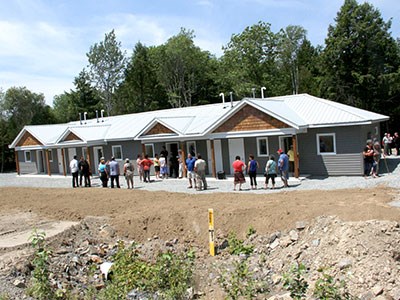A new form of housing in Atikameksheng Anishnawbek First Nation is being hailed as an important step forward in addressing chronic housing issues in First Nations across Canada.
The community just outside of Sudbury, formerly known as Whitefish Lake, unveiled a four-unit complex, the first built with the First Nations Sustainable Development Standard as the guide. Using a new type of concrete, the homes are resistant to mold and fire, and were built using non-toxic materials.
Developed in partnership with several groups – including the Mike Holmes Foundation and the Assembly of First Nations – the standard is more than just a building code. Irving Leblanc, the associate director of housing, infrastructure and emergency issues with the Assembly of First Nations, said the code encompasses a range of issues.
“It's not just about how you build a house, it's how you build a community, how you plan a community and move it away from flood plains,” Leblanc said at the July 11 ceremony unveiling the new units. “It's a great document that really looks at all aspects of community planning.”
The standard has been in the works since 2010, when Atikameksheng Anishnawbek was picked for the pilot project to work with the Holmes Group to build the units. It was developed over a three-year period, and includes such principles as assessing the best location for the homes, identify training needs for local residents, addressing financing issues, and identifying the most suitable building materials for the particular area.
Other partners included Francis Lapointe of Lapointe Architects – who said his goal was to “put himself out of a job” by designing a model home that will last. And a new type of concrete was used – known Insulated Concrete Form – that is mold and fireproof.
Developed by Third Line Homes, the concrete also has built in sensors that send out data on the condition of the walls. The concrete also absorbs moisture when it's humid, and release it when it gets dry.
“These are homes that are healthy and sustainable,” said Jan Singbeil, of Third Line. “These homes will not burn down. These homes will not blow away.”
Leblanc said too many First Nations were built on flood plains, causing a host of problems.
“A lot of the problems are due to mold, and that comes from water problems and poor building practices,” he said. “The goal is to build better, longer-lasting homes – healthy homes, green homes.”
Grand Council Chief Patrick Madahbee said the cycle of First Nations people living in substandard housing – only to be replaced by more substandard housing – must end. He's not aware of any First Nation in Canada that doesn't have a long waiting list of people waiting for homes.
“And what this does is get to the heart of (how) we can get these people good quality housing,” Madahbee said. “Atikameksheng Anishnawbek needs to be congratulated for this project, as well as all the partners involved.”
He likes the fact the standard also deals with financing issues problem unique to First Nations, because of land ownership rules. That draws out the process, meaning building often begins in the winter, driving up costs and making cutting corners much more of a problem. And First Nations are only eligible to receive around $35,000 for construction costs, Madahbee said, an amount that hasn't gone up even as costs increase.
“Every year, building costs and the cost of labour increase, but the funding has stayed the same for years,” he said. “In fact, particularly here in Ontario, capital funding has been almost non-existent … As we've seen in the past, when things aren't built to standard, the housing doesn't last long.
“So when First Nations get an opportunity to participate in a project like this, it's very beneficial to the community.”




